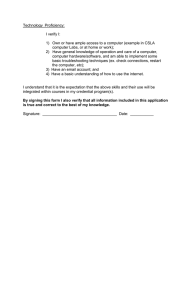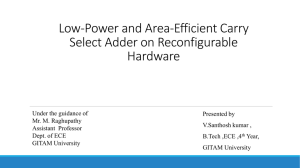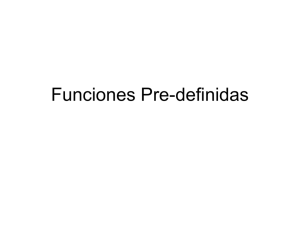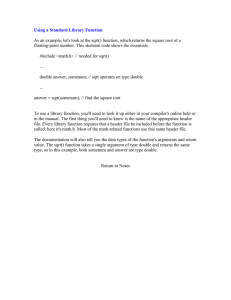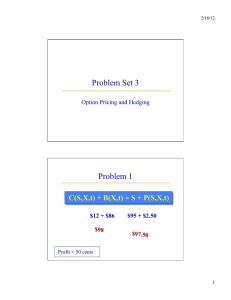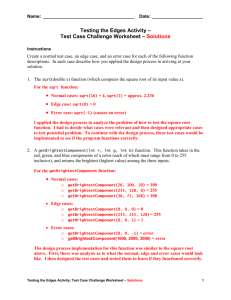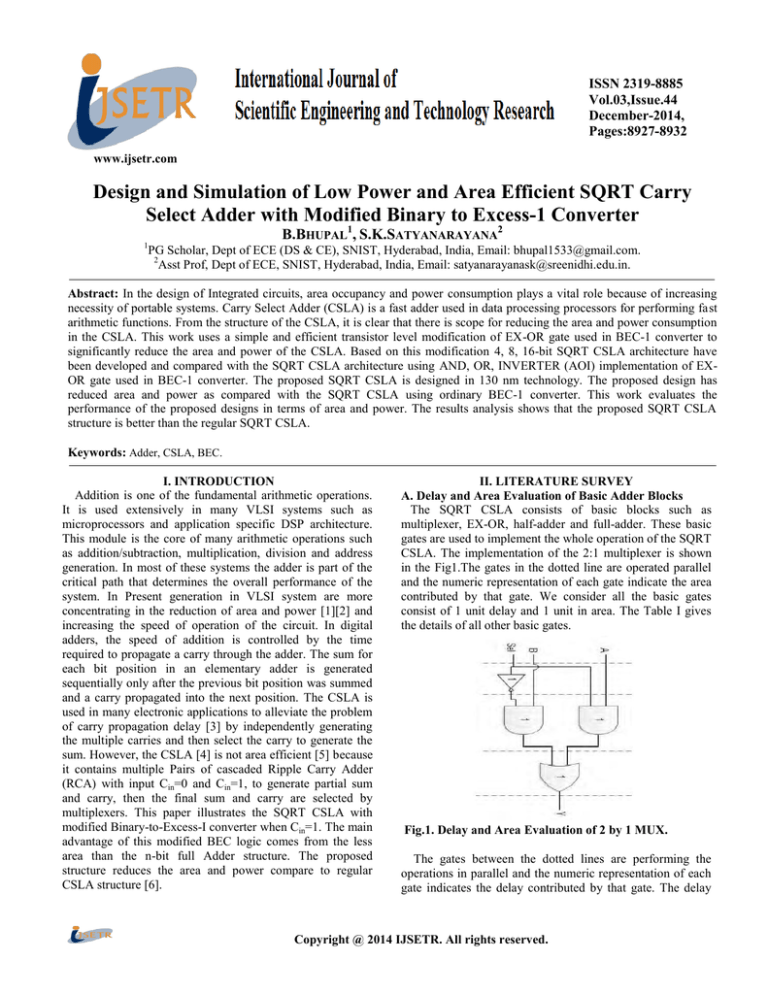
ISSN 2319-8885
Vol.03,Issue.44
December-2014,
Pages:8927-8932
www.ijsetr.com
Design and Simulation of Low Power and Area Efficient SQRT Carry
Select Adder with Modified Binary to Excess-1 Converter
B.BHUPAL1, S.K.SATYANARAYANA2
1
PG Scholar, Dept of ECE (DS & CE), SNIST, Hyderabad, India, Email: bhupal1533@gmail.com.
2
Asst Prof, Dept of ECE, SNIST, Hyderabad, India, Email: satyanarayanask@sreenidhi.edu.in.
Abstract: In the design of Integrated circuits, area occupancy and power consumption plays a vital role because of increasing
necessity of portable systems. Carry Select Adder (CSLA) is a fast adder used in data processing processors for performing fast
arithmetic functions. From the structure of the CSLA, it is clear that there is scope for reducing the area and power consumption
in the CSLA. This work uses a simple and efficient transistor level modification of EX-OR gate used in BEC-1 converter to
significantly reduce the area and power of the CSLA. Based on this modification 4, 8, 16-bit SQRT CSLA architecture have
been developed and compared with the SQRT CSLA architecture using AND, OR, INVERTER (AOI) implementation of EXOR gate used in BEC-1 converter. The proposed SQRT CSLA is designed in 130 nm technology. The proposed design has
reduced area and power as compared with the SQRT CSLA using ordinary BEC-1 converter. This work evaluates the
performance of the proposed designs in terms of area and power. The results analysis shows that the proposed SQRT CSLA
structure is better than the regular SQRT CSLA.
Keywords: Adder, CSLA, BEC.
I. INTRODUCTION
Addition is one of the fundamental arithmetic operations.
It is used extensively in many VLSI systems such as
microprocessors and application specific DSP architecture.
This module is the core of many arithmetic operations such
as addition/subtraction, multiplication, division and address
generation. In most of these systems the adder is part of the
critical path that determines the overall performance of the
system. In Present generation in VLSI system are more
concentrating in the reduction of area and power [1][2] and
increasing the speed of operation of the circuit. In digital
adders, the speed of addition is controlled by the time
required to propagate a carry through the adder. The sum for
each bit position in an elementary adder is generated
sequentially only after the previous bit position was summed
and a carry propagated into the next position. The CSLA is
used in many electronic applications to alleviate the problem
of carry propagation delay [3] by independently generating
the multiple carries and then select the carry to generate the
sum. However, the CSLA [4] is not area efficient [5] because
it contains multiple Pairs of cascaded Ripple Carry Adder
(RCA) with input Cin=0 and Cin=1, to generate partial sum
and carry, then the final sum and carry are selected by
multiplexers. This paper illustrates the SQRT CSLA with
modified Binary-to-Excess-I converter when Cin=1. The main
advantage of this modified BEC logic comes from the less
area than the n-bit full Adder structure. The proposed
structure reduces the area and power compare to regular
CSLA structure [6].
II. LITERATURE SURVEY
A. Delay and Area Evaluation of Basic Adder Blocks
The SQRT CSLA consists of basic blocks such as
multiplexer, EX-OR, half-adder and full-adder. These basic
gates are used to implement the whole operation of the SQRT
CSLA. The implementation of the 2:1 multiplexer is shown
in the Fig1.The gates in the dotted line are operated parallel
and the numeric representation of each gate indicate the area
contributed by that gate. We consider all the basic gates
consist of 1 unit delay and 1 unit in area. The Table I gives
the details of all other basic gates.
Fig.1. Delay and Area Evaluation of 2 by 1 MUX.
The gates between the dotted lines are performing the
operations in parallel and the numeric representation of each
gate indicates the delay contributed by that gate. The delay
Copyright @ 2014 IJSETR. All rights reserved.
G.NALINI, KONDAVEETI SUDHARANI
and area evaluation methodology considers all gates to be
The Boolean expressions of the 4-bit BEC is listed as
made up of AND, OR, and Inverter, each having delay equal
X0 = ~ B0
to 1 unit and area equal to 1 unit. We then add up the number
X1 = B0 ^ B1
of gates in the longest path of a logic block that contributes to
X2 = B2 ^ (B0 & B1)
the maximum delay. The area evaluation is done by counting
X3=B3 ^ (B2 & (B1&B0))
the total number of AOI gates required for each logic block.
Table I Delay and area count of adder blocks
Delay and Area count of Basic blocks
Adder blocks
Delay
Area
2:1
MULTIPLEXER
EX-OR
3
4
3
5
HALF ADDER
3
6
FULL ADDER
6
13
B. Binary to Excess -1 Converter (BEC)
BEC-I is a circuit used to add 1 to the input numbers .A
circuit of 4-bit BEC [7] and the truth table is shown in Fig.2
and Table II respectively. The goal of addition is achieved
using BEC together with a multiplexer shown in Fig.3, one
input of the 8:4 multiplexer gets as it input (B3, B2, B1, and
B0) and another input of the multiplexer is the BEC output.
Fig2. 4-bit BEC-I.
Table II. Function table of the 4-b BEC
Fig3. BEC with MUX.
The main idea of this work is to use BEC instead of the
RCA with Cin=1 in order to reduce the area and power
consumption of the conventional CSLA. To replace the n-bit
RCA, an n+1 bit BEC is required.
C. Area Evaluation Methodology of Regular SQRT
CSLA.
The basic square root Carry select adder has a dual ripple
carry adder with 2: 1 multiplexer the main disadvantage of
regular CSLA is the large area due to the multiple pairs of
ripple carry adder. The regular 16-bit Carry select adder is
shown in Fig.4. It is divided into five groups with different
bit size RCA. From the structure of Regular CSLA [9], there
is scope for reducing area and power consumption. The carry
out calculated from the last stage i.e. least significant bit
stage is used to select the actual calculated values of the
output carry and sum. The selection is done by using a
multiplexer. Internal structure of the group 3 of regular 16-bit
CSLA is shown Fig.5.By manually counting the number of
gates used for group 3 is 87. One input to the multiplexer
goes from the RCA with Cin=0 and other input from the RCA
with Cin=1.
Fig.4. Regular 16-bit SQRT CSLA.
International Journal of Scientific Engineering and Technology Research
Volume.03, IssueNo.44, December-2014, Pages: 8927-8932
High Speed and Power Optimized Scalable Comparator using Parallel Prefix Tree
Fig5. Delay and area evaluation for group3.
Fig7. Group 3 for Modified SQRT CSLA.
Area count of Regular SQRT CSLA groups as follows in
the table III.
Comparing the group 3 of both regular and modified
CSLA, it is clear that BEC structure reduces the area and
power. Area count of Modified SQRT CSLA groups as
follows in the table IV.
Table IV. Area count of Modified SQRT CSLA
GROUP
AREA COUNT
Table III. Area count of Regular SQRT CSLA
GROUP
AREA COUNT
GROUP1
26
GROUP2
57
GROUP3
87
GROUP4
117
GROUP5
147
From Table III, the total number of gate counts in
group3 is determined as follows:
Gate count = 87 (HA + FA + Mux)
FA = 65 (5 * 13)
HA = 6 (1 * 6)
Mux = 16 (4 * 4)
D. Area Evaluation Methodology Of Modified SQRT
CSLA
The structure of the proposed 16-b SQRT CSLA using
BEC [7] for RCA with Cin=1to optimize the area and power
is shown in Fig. 6. We again split the structure into five
groups.
Fig6. Modified 16-bit SQRT CSLA.
GROUP1
26
GROUP2
43
GROUP3
66
GROUP4
89
GROUP5
113
From Table IV, the total number of gate counts in
group3 is determined as follows:
Gate count = 66 (HA + FA + Mux + BEC)
FA = 26 (2 * 13)
HA = 6 (1 * 6)
AND=2 (2 * 1)
NOT=1
Mux = 16 (4 * 4)
EX-OR=15(3*5)
Comparing Tables III and IV, it is clear that the 16 bit
modified SQRT CSLA has less area than the regular SQRT
CSLA.
III.PROPOSED METHOD
Though BEC technique reduces area and power but not up
to considerable amount. There is a scope to reduce the
number of transistors along with the area reduction and
power dissipation reduction by using proposed logic. The
modified SQRT CSLA using BEC is designed with AOI
implementation. The AND, OR, and Inverter (AOI)
implementation of an EX-OR gate is shown in Fig.8.
Schematic view of AOI implementation of EX-OR gate as
shown in the Fig 8.It consists 22 transistors. The area can be
considered as number of transistors. In the proposed design
EX-OR gate can be designed with 12 transistors, then area
and power dissipation will be decreased. The modified EXOR gate as shown in the Fig.9.
International Journal of Scientific Engineering and Technology Research
Volume.03, IssueNo.44, December-2014, Pages: 8927-8932
G.NALINI, KONDAVEETI SUDHARANI
The 4-bit proposed SQRT Carry Select Adder is designed
by using 2-bit Ripple carry adder and 3-bit modified Binary
to Excess-1 converter and multiplexer. The outputs of ripple
carry adder are given as inputs to the 3-bit modified Binary to
Excess-1 converter. The 4-bit proposed SQRT CSLA has one
2-bit Ripple Carry Adder for Cin=0. Instead of another 2-bit
Ripple Carry Adder with Cin=1, a 3-bit modified Binary to
Excess-1 converter is used which adds one to the output from
2-bit RCA. The Final sum will be selected from multiplexers
by the carry out generated by the pervious block. The
proposed 4-bit SQRT CSLA is designed in 130nm
technology. The Schematic view of 4-bit proposed SQRT
CSLA is shown in the Fig.11.
Fig8. Schematic view of AOI implementation of EX-OR
gate.
Fig9. Schematic view of modified EX-OR gate.
The Binary to Excess-1 converter is designed with modified
EX-OR gates, AND gates and Inverter gate, then the area and
power dissipation will be decreased compare to the Binary to
Excess-1 converter is designed with AOI implementation.
The modified BEC is designed in 130 nm technology. The
modified3-bit BEC is shown in the Fig.10.
Fig.10.Schematic view of modified 3-bit BEC-1 converter.
Fig11. Schematic view of 4 bit proposed SQRT CSLA.
Based on this modification 4, 8, 16-bit SQRT CSLA
architecture have been developed and compared with the
SQRT CSLA architecture using AOI implementation of EXOR gate used in BEC-1 converter. The proposed SQRT
CSLA is designed in 130 nm technology. The proposed
design has reduced area and power as compared with the
SQRT CSLA using ordinary BEC-1 converter. The proposed
SQRT Carry Select Adder is designed in 130 nm technology.
The proposed design has reduced area and power as
compared with the regular SQRT CSLA.
IV.RESULT
The Electric tool is used for the schematic generation and
also for the layout generation. By this we can generate the
spice netlist for the LT-SPICE code which is used for the
checking the waveforms and the generation of the results.
The proposed SQRT Carry Select Adder is designed in 130
nm technology. And also we can calculate the average power
of the circuit and the theoretical area used by the circuit.
International Journal of Scientific Engineering and Technology Research
Volume.03, IssueNo.44, December-2014, Pages: 8927-8932
High Speed and Power Optimized Scalable Comparator using Parallel Prefix Tree
A.3-bit Modified Binary to Excess-1 Converter LAYOUT
Design
Fig14.Timing diagram of 4-bit proposed SQRT CSLA in
130nm technology.
Fig12. Layout design of 3-bit Modified Binary to Excess-1
Converter in 130nm technology.
Fig.12 shows the layout design of modified 3-bit BEC in
130 nm technology. It consists two modified EX-OR gates,
one AND gate and one inverter. The advantages of modified
BEC are area and power consumption reduced compared to
the regular BEC.
B.4-bit Proposed SQRT CSLA LAYOUT Design
Fig15.Power analysis of 4-bit proposed SQRT CSLA in
130nm technology.
Table V. comparison of area and power consumption of
Regular SQRT CSLA, Modified SQRT CSLA, and
Proposed SQRT CSLA.
Fig13.Proposed layout design of 4-bit SQRT CSLA in
130nm technology.
Fig.13 shows the layout design of proposed 4-bit SQRT
CSLA in 130nm technology. It consists two 2-bit RCA, one
modified BEC and one 6:3 multiplexer. The power
dissipation of proposed 4-bit SQRT CSLA in 130nm
technology is 37.84µw is shown in the Fig.15.
International Journal of Scientific Engineering and Technology Research
Volume.03, IssueNo.44, December-2014, Pages: 8927-8932
G.NALINI, KONDAVEETI SUDHARANI
Table V. shows area and power consumed by the 4-bit, 8bit, 16-bit proposed SQRT Carry Select Adders. The
proposed SQRT CSLA is designed in 130nm technology has
less power consumption and less area compared to the
existence techniques.
V.CONCLUSION
A simple design is proposed for implementing the SQRT
Carry Select Adder with the help of Ripple Carry Adder for
Cin=0 and Binary to Excess-1 converter with 12 transistor
XOR gate. The SQRT Carry Select Adder is designed in
130nm technology. The reduction in the number of
transistors of this work offers great advantage in terms of
area and power. The proposed design has reduced area and
power as compared with the regular SQRT CSLA with dual
Ripple Carry Adders for Cin=0 and Cin=1 and modified Carry
Select Adder. This work evaluates the performance of the
proposed designs in terms of area and power. The results
analysis shows that the proposed CSLA structure is better
than the regular SQRT CSLA and modified SQRT CSLA.
This work can be further extended for higher number of bits.
New architectures can be designed with less number of
transistors and developed to achieve the better results in
terms of area, power and delay.
VI. REFERENCES
[1] Anantha P.Chandrakasan and Samuel Sheng “Low-Power
CMOS Digital Design” IEEE Journal Of Solid-State
Circuits.Vol.27, No.4, April 1992.
[2] E. Abu-Shama and M. Bayoumi “A New Cell for Low
Power Adders” IEEE 1996.
[3] Chetana Nagendra, Mary Jane Irwin, and Robert Michael
Owens “Area-Time-Power Trade-offs in Parallel Adders”
IEEE Transactions on Circuits and Systems-11: Analog And
Digital Signal Processing, Vol. 43, No. 10, October 1996.
[4]J. BEDRIJ “Carry Select Adder” IRE Transactions On
Electronic Computers.
[5] AKHILESTHY AG “A Reduced Area Scheme for CarrySelect Adders” IEEE 1990.
[6] Yotmgjoon Kim and Lee-Sup Kim “A Low Power Carry
Select Adder With Reduced Area” IEEE 2001.
[7] B. Ramkumar and Harish M Kittur “Low-Power and
Area-Efficient Carry Select Adder” IEEE Transactions On
Very Large Scale Integration (VLSI) Systems, VOL. 20, NO.
2, February 2012.
[8]. Shivani Parmar,Kirat Pal Singh “Design of high speed
hybrid carry select adder”IEEE 2012.
[9]. Partha Mitra1, Debarshi Datta “Low Power High Speed
SQRT Carry Select Adder” IOSR Journal of VLSI and Signal
Processing (IOSR-JVSP) Volume 1, Issue 3 (Nov. - Dec.
2012).
International Journal of Scientific Engineering and Technology Research
Volume.03, IssueNo.44, December-2014, Pages: 8927-8932

